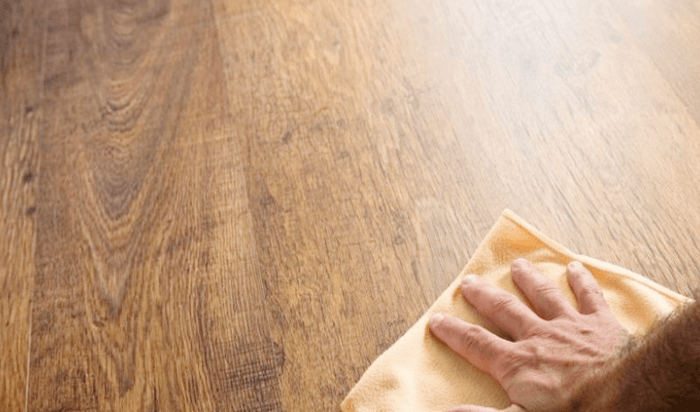Engineered hardwood floors are an amazing choice of flooring. They are long-lasting and easy to maintain and clean. Everything is great until you start seeing haze appearing on your floor.
You may ask yourself why this may be happening and how you can remove the haze from your floor. Well, you are at the right place, because we have all the answers here for you.
If you are looking to remove haze from your engineered hardwood floors, then dive right in! Make sure you stay with us until the end!
Contents
What Are Engineered Hardwood Floors
A good place to start is to understand what are engineered hardwood floors. Engineered hardwood floors have layers of plywood along with hardwood. These floors are much more durable than regular solid hardwood floors. These layers are arranged on top of one another in different directions.

Engineered hardwood floors have many more advantages over traditional floors. These are easier to maintain and clean. They can be custom ordered with any color and design. They have many finishes, including matte, gloss, and plain.
Possible Causes For Formation Of Haze
There are multiple sources of problems and reasons for haze to form on your engineered hardwood floors. Understanding these causes are very important before attempting to fix your problem.
Using Wrong Cleaning Materials
Using improper products to clean your engineered hardwood flooring is the most likely cause of haze appearing on your floor. There are countless floor cleaning products in the market. Most of the time, people tend to select the wrong product for their floor.
Before using any cleaning chemicals, be sure to read the labels to identify whether it is the perfect product for the type of floor you have in your house. Especially when you are using a wood-based floor, it is essential to check the chemicals in your cleaner as wood-based floors are more susceptible to damage.
Choosing the right product can be challenging. However, you need to avoid oil-based cleaners if you are using hardwood floors. The polyurethane seal gets damaged due to reaction with the oils. As a result, the oil can seep into the flooring.
You should also try to avoid using any wax, oil soaps, and floor polish. The residue from these types of products can build up on your floor. This lead to a cloudy white appearance forming on the surface of your floor.
There are some cleaners containing water in the solution. The water leaves cloudy streaks on the wooden floor. When you apply too much cleaner on the floor, it can lead to a build-up of residue.
If you want to avoid these marks, try to use the products as little as possible. It is also a good idea to consult a professional to ask about what kind of product you can use.
Poor Application Finishing Of The Floors
Floor finishing is a crucial part of installing the floor. It is important to ensure that there is no air trapped when you are applying the finish.
At times, there can be bubbles of air trapped while applying the finish. This can cause a hazy appearance under the finish of the floor. This also happens if the finish is applied on scratched surfaces, so you should keep that in mind as well.
Excess Wax
Some floors can be waxed to keep them clean and shiny. However, not all engineered hardwood floors can be waxed, especially when the floor surface is chipped, scratched, or old.
Excess waxing on a floor can lead to build-up of wax on the floor. Gradually, this can look like a white film of haze on the floor surface.
Salt Deposits On Floor
Salts are often present in the chemical solutions used for cleaning. When used in excess, these salts can react with the floor finish and cause a hazy appearance. Salt can also spill on floors accidentally. If these are not removed quickly, it can cause a residue buildup on the floors.
Methods Of Cleaning
Once you have located the cause of your problems, you can take appropriate measures to tackle your problems.
Steam Cleaning
Steam cleaning is a great way to remove marks and stains from your floor. It is usable on hardwood floors as well. This method also kills the germs on your floor surface using high-temperature steam.
However, there are certain things to keep in mind before you start steam cleaning on your engineered hardwood floors. Your floor surface must be properly sealed; otherwise, the steam can come in contact of the wooden surface below.
Steam mops use water instead of chemicals. While using this, you need to be very alert so that you do not keep the mop in one place for a long time. Doing so will result in water buildup and the formation of haze.
Vinegar Cleaning Method
If your haze is formed by salt deposits, vinegar is the proper substance to use. For this, we will make use of white vinegar as it is a natural compound and non-toxic.
Vinegar is a very commonly used household product to deal with floor haze. It contains a small amount of acid and can clean the cloudiness very quickly. However, the amount should be carefully maintained.
Pour water in a bucket and add about two cups of vinegar. Gently mix to make sure it is properly dissolved. Before cleaning, remove all furniture from your floor.
Use a wet microfiber cloth and gently rub the areas which have become cloudy. After cleaning the floor with vinegar, wipe it off using a dry cloth to remove any traces.
Ammonia
Ammonia is also used as a great cleaning material for floors. This can effectively remove haziness, but many people choose not to use it due to its strong smell.
The method of cleaning is the same as cleaning with vinegar.
Conclusion
That is all for this article. I have discussed all the important points in great detail so that you guys have no difficulties understanding. I hope this guide has helped you guys out in dealing with haze on your engineered hardwood floors.

Do you think I can use a buffing machinesTo remove the jade from my floors
Thanks Inita Roach,
Can you please explain what is “jade”?